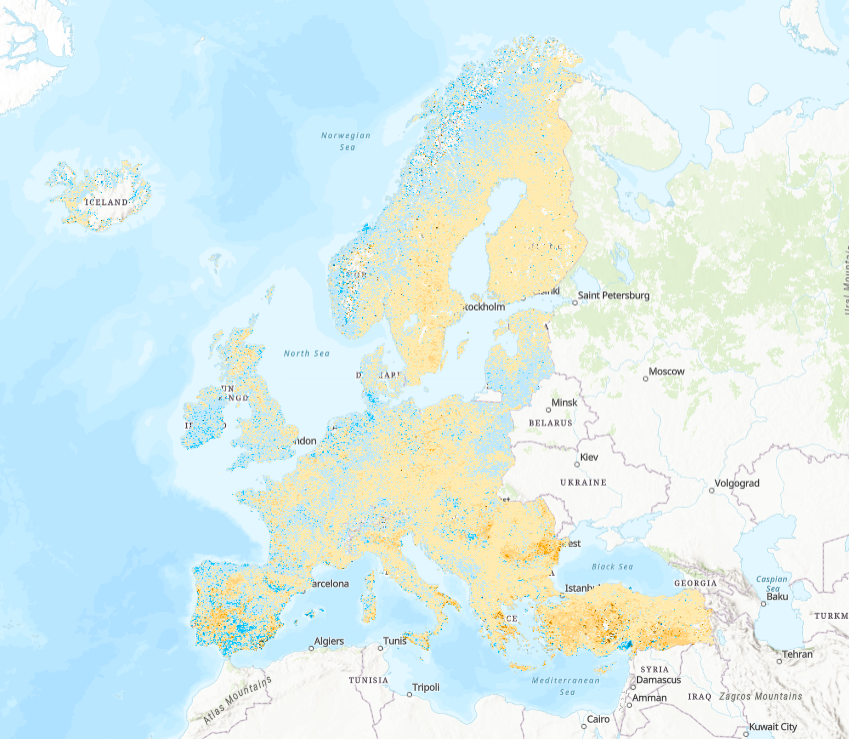500 m
Type of resources
Available actions
Topics
INSPIRE themes
Keywords
Contact for the resource
Provided by
Years
Formats
Representation types
Update frequencies
Resolution
-

This raster data set corresponds to the above ground vegetation biomass productivity time-series for the period 2000-2016. The data set addresses trends in land surface productivity derived from remote sensing observed time series of vegetation indices. The vegetation index used in the indicator is the Plant Phenology Index (PPI, Jin and Eklundh, 2014). PPI is based on the MODIS Nadir BRDF-Adjusted Reflectance product (MODIS MCD43 NBAR. The product provides reflectance data for the MODIS “land” bands (1 - 7) adjusted using a bi-directional reflectance distribution function. This function models values as if they were collected from a nadir-view to remove so called cross-track illumination effects. The Plant Phenology Index (PPI) is a new vegetation index optimized for efficient monitoring of vegetation phenology. It is derived from radiative transfer solution using reflectance in visible-red (RED) and near-infrared (NIR) spectral domains. PPI is defined to have a linear relationship to the canopy green leaf area index (LAI) and its temporal pattern is strongly similar to the temporal pattern of gross primary productivity (GPP) estimated by flux towers at ground reference stations. PPI is less affected by presence of snow compared to commonly used vegetation indices such as Normalized Difference Vegetation Index (NDVI) or Enhanced Vegetation Index (EVI). The product is distributed with 500 m pixel size (MODIS Sinusoidal Grid) with 8-days compositing period.
-

The raster file is the time series of the start of the vegetation growing season. The start of the growing season time-series is based on the time series of the Plant Phenology Index (PPI) derived from the MODIS BRDF-Adjusted Reflectance product (MODIS MCD43 NBAR). The PPI index is optimized for efficient monitoring of vegetation phenology and is derived from the source MODIS data using radiative transfer solutions applied to the reflectance in visible-red and near infrared spectral domains. The start of season indicator is based on calculating the start of the vegetation growing season from the annual PPI temporal curve using the TIMESAT software for each year between and including 2000 and 2016.
-

The raster file is the temporal trend in above ground vegetation biomass productivity. The vegetation productivity dataset is based on the time series of the Plant Phenology Index (PPI) derived from the MODIS BRDF-Adjusted Reflectance product (MODIS MCD43 NBAR). The PPI index is optimized for efficient monitoring of vegetation phenology and is derived from the source MODIS data using radiative transfer solutions applied to the reflectance in visible-red and near infrared spectral domains. The productivity indicator is based on calculating the area under the PPI temporal curve above the baseline (large integral - LINT) using the TIMESAT software. Relative change of vegetation productivity was then calculated as (YfitLINT2016 – YfitLINT2000)/YfitLINT2000 and expressed in percent scale [%]. Negative values refer to decrease in vegetation productivity, whereas positive values refer to increase in vegetation productivity.
-

This data set raster file is the above ground vegetation season length time-series for the period 2000-2016. The data set addresses trends in the season length of land surface vegetation derived from remote sensing observed time series of vegetation indices. The vegetation index used in the indicator is the Plant Phenology Index (PPI, Jin and Eklundh, 2014). PPI is based on the MODIS Nadir BRDF-Adjusted Reflectance product (MODIS MCD43 NBAR). The product provides reflectance data for the MODIS “land” bands (1 - 7) adjusted using a bi-directional reflectance distribution function. This function models values as if they were collected from a nadir-view to remove so called cross-track illumination effects. The Plant Phenology Index (PPI) is a new vegetation index optimized for efficient monitoring of vegetation phenology. It is derived from radiative transfer solution using reflectance in visible-red (RED) and near-infrared (NIR) spectral domains. PPI is defined to have a linear relationship to the canopy green leaf area index (LAI) and its temporal pattern is strongly similar to the temporal pattern of gross primary productivity (GPP) estimated by flux towers at ground reference stations. PPI is less affected by presence of snow compared to commonly used vegetation indices such as Normalized Difference Vegetation Index (NDVI) or Enhanced Vegetation Index (EVI). The product is distributed with 500 m pixel size (MODIS Sinusoidal Grid) with 8-days compositing period.
-

The raster file is the temporal trend in the start of the vegetation growing season. The start of growing season dataset is based on the time series of the Plant Phenology Index (PPI) derived from the MODIS BRDF-Adjusted Reflectance product (MODIS MCD43 NBAR). The PPI index is optimized for efficient monitoring of vegetation phenology and is derived from the source MODIS data using radiative transfer solutions applied to the reflectance in visible-red and near infrared spectral domains. The start of season dataset is based on calculating the start of the growing season from the annual PPI temporal curve using the TIMESAT software. Change in the start of growing season was then calculated after fitting a linear trend and extracting the slope of the trend. Negative values refer to earlier start of the vegetation growing season, whereas positive values refer to later start of the vegetation growing season.
 RUC Geo-Data catalogue
RUC Geo-Data catalogue